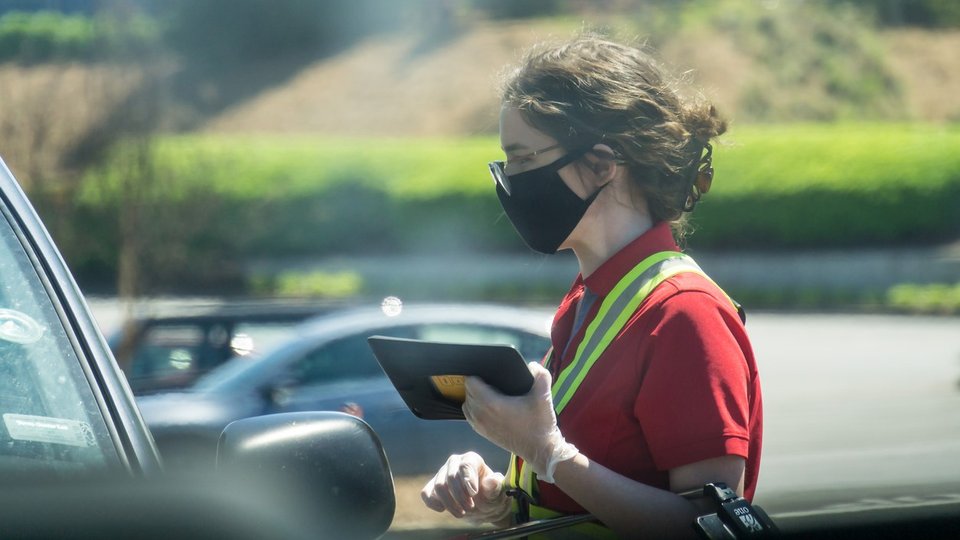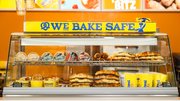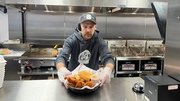Operations
Making 'masked' hospitality work: Cost, customer engagement challenge QSRs
In a COVID-19 world, masks have become a fact of life for restaurant operators and employees. The question now is how to use them safely and cost-effectively, while somehow still conveying warmth and hospitality.

June 2, 2020 by S.A. Whitehead — Food Editor, Net World Media Group
Customer experience has always been central to any restaurant operation, but it's tough to engage diners, let alone convey anything akin to warmth and hospitality through just about any traditional restaurant employee face mask. Granted, clear plastic mask varieties afford a view of the restaurant worker's welcoming face, but then those varieties also have drawbacks (hello mouth and nose exhaust or heaven forbid, a sneeze).
But that is, indeed, where many restaurant operators find themselves these day thanks to that microscopic mayhem-maker, known as the COVID-19 virus. States like Texas, do afford operators some leeway on this, since lawmakers there have left the option open whether restaurant workers or diners wear masks – though even that is being contested. But for the most part, brands are still "masking up" like gunfighters at the O.K. Corral.
And with good reason, since in the U.S., those doyens of all things disease-related at the Centers for Disease Control and Prevention recommend everyone don cloth face coverings in any public setting where it can be difficult to remain 6 feet apart at all times.
As a result of that fact, mask-producing companies like Wilmington, Delaware-based, Jiffyshirts.com, is getting slammed by its regular restaurant uniform clients for thousands of face masks, now that Jiffy has begun producing those to meet clients' needs.
"They're coming to our website and saying, 'We need the orders yesterday!'" relayed the newly launched, JiffyMasks.com's Vice President of Sales Jason Buchanan, in an interview with this website.
In Jiffy's case, restaurant brands are urgently ordering the non-medical face-coverings the CDC has recommended, which the company makes from the mostly cotton T-shirt-type of material it also uses for some restaurant uniforms.
"They're coming to our website and saying, 'We need the orders yesterday!'"
-JiffyMasks.com's Vice President of Sales Jason Buchanan
The brand makes single-, double- and triple-ply fabric masks, each designed to fit restaurants' personal protective equipment policies and budgets. Jiffy's single-layered masks serve as disposable, one-time use face coverings and the double- and triple-layered versions for repeated use.
But again, these will not necessarily protect anyone wearing them from being exposed to the virus, according to Buchanan, as these types of non-medical grade masks are simply intended to curtail transmission by the worker wearing the mask.
"These are for the person that maybe asymptomatic to keep them from spreading it," Buchanan said. "But these are not barrier that are going to prevent me from getting it. … So in the restaurant world, these prevent an employee from (passing it) on to somebody else."
In a perfect world, everyone else would also be wearing masks, to prevent each individual from transmitting the virus if they're infected. But last time we checked, this was far from a perfect world.
Even if employees are religiously complying to mandates to wear masks, there are still many factors that can hamper their effectiveness. The media and social media have documented lots of incidents where restaurant employees either push masks down around their necks or go without them altogether.
In fact, Buchanan recently ate at a fast food restaurant where the employee at the drive-thru had her mask pushed down around her neck. So he did a little investigation into why she chose to do so. She replied simply, "They get all yucky inside."
Buchanan said he did not doubt that reasoning and it points a training need for restaurant operators about how to use masks effectively.
"What all manufacturers recommend is when the cloth-based cover becomes damp, it's time to change it out because that allows bacteria to grow … and as you can see is also why employees start taking them off. … It feels yucky inside."
Mask hysteria: Yes, yet another operational cost
But that also brings up a factor that every restaurateur reading this article is probably already pondering by now: How many face masks can they feasibly provide each of their workers each day during each shift to provide adequate replacements as needed? Even if brands can strictly enforce that the masks should be replaced as soon as employees detect dampness, how much does providing all those masks add to the brand's already strained bottom line?
To give readers an idea, we started with the constant of getting an estimate of how much Buchanan estimated a QSR with about 50 total employees would require in disposable masks for a week across all shifts. He said that would probably be around 1,000 face covers, though that's also dependent on the unit's hours of service.
At Jiffy, the brand's 50/50 cotton/poly masks go for about 92 cents a piece if they are purchased in 2,400-quantity packages, or $920 each week in added operational costs per store. Granted brands could purchase longer-lasting washable/reusable masks, but they are more costly and would still have to be supplied in bulk so employees could change them as needed throughout the day.
To get an idea whether such usage numbers really even jibe with the reality of what a typical QSR brand is using, we checked with a handful of brands. Unfortuantely, but we were unable to obtain any solid numbers on either the quantity of face masks being used per store or per employee or the cost expended.
However, at Lexington, Kentucky-based A&W, Bill Frye, senior vice president of restaurant support services and supply chain management, said its purchasing co-op, Restaurant Supply Chain Solutions, is making both disposable and reusable masks available to all of its restaurants.
"Franchisees can use either," Frye told this website. "The cost on a daily basis is about the same — typically between $20 and $30. Franchisees purchase the masks."
It adds up, of course, making it clear to see how just this one (of many) COVID-19-related expense could drag down a brand's overall financial performance. But the fact that these masks allow restaurants to stay in business and keep customers comfortable remains paramount. And since all QSRs are experiencing the same added expenses, the playing field is leveled to some degree.
The challenge: masked hospitality
Aside from the added cost of this one piece of PPE, brands still have the challenge of engaging customers essentially without the use of half of workers' faces and their expressions of warmth and friendliness.
On that matter, another mask supplier we contacted, C-Suite Supplies, had this to say about how brands should coach employees about showing hospitality from behind their face coverings.
"For every fast food restaurant operator. the smile has been always a big part of guest experience and masks cover the smile," CEO Jeffrey Hayzlett acknowledged. "Restaurants must realize that wearing a mask does not mean a team member should not smile. A smile is an attitude and having a smile even behind the mask will reflect on the positive welcoming energy of the team member.
"Masks are essential and good business. "I'm not a doctor, I'm not a nurse and I can't sew a mask, but I am a business person. Wearing a mask is not only doing a duty for those around you, but for yourself as well. Now more than ever, we all need a little hope and ensuring the peace of mind of all employees is essential. … Let us simply celebrate the momentum, and just look at masks as a transition training wheel, that will surely come off when we get to a safer world."
Well said. And if any restaurateurs reading today have some great things their brands are doing to further guest engagement, even with the masks on, please email editor@QSRweb.com as we'd love to share some of those ideas, if you're willing.
About S.A. Whitehead
Pizza Marketplace and QSRweb editor Shelly Whitehead is a former newspaper and TV reporter with an affinity for telling stories about the people and innovative thinking behind great brands.









